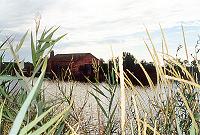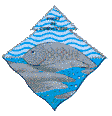|
|
|
Life
in the valleys
|
|
"Casoni"
|
The organization of fishing in the Comacchio Valleys
melts, from always, on the cases: sites of working activities and until few years ago accomodations of the Valleys inhabitants in the stays in
valley. Hut built with poles and dressed again of vegetable material, called
grisola, a set of swampy cane bundles, wrapped with the paviera (reed or carex fibre). Only from 17th century inhabitants started to build them in masonry and with more
vain. They are characterized by a modest height and reduced doors and windows. Their function was
double:
1. Fishing stations: the inhabitant who played this activity stayed here. It was always present a fire - place for the heating and cooking the food, almost exclusively constituted by fish and polenta.
|
Every house had generally a
tabarra, a warehouse - laboratory for the building and maintenance of the fishing tools by and some handmade articles of current
use, almost always characterized by objects in grisola, used for the
lavorieri.
2. Ambush stations: they were often supplied with tower with sentry - box
(like the Foce case), which was serving for the vigilance of the velley
guards, against the illicit fishing, practised by the fiocinini (poach fishers which used
harpoon). In addition to the cases there were the Cavane, that is cabins for the shelter of the
boats.
|
Clic
on image
|
|

|
The organization and the positioning of the cases were taking place on the basis of the subdivision of the four valley
districts, of their extent, of the labour used in each one and the amount of fished
for. In every quarter there was generally a principal case and a few
minors. Today are visitable two ambush cases (Foce and
Coccalino) and three fishing: Foce, place of business case of the Bettolino di Foce restaurant, the Serilla case, which was one of the
biggest, supplied with tabarra and cavanna, and a less case, the
Pegoraro. Five fishing stations and seven supervision houses are active at
present.
|
|
The
"Lavoriero"
|
The lavoriero is a very ancient
tool, but still efficient and fundamental for the valley fishing, which allows to capture the eels separately from grey mullets and other
fishes, during their migrations at sea, stimulated by the reproductive
instinct.
It is a handmade article formed by a series of communicating basins, to arrow tip
form: a time was entirely built in grisole (swampy cane strips bound by
paviera) and poles, while today is in cement and metallic grills. Anyway the system of capture is substantially
|
|
Clic
on image
|
the same one as the
past: beyond the numerous and dark legends bound to the place of reproduction of the eel (Sargasso
Sea), it's sure that in a certain period of the year all the valley fishes feel the instinct to emigrate to sea and vice versa to go back to the
valley. The lavoriero makes them converge in forced passages and captures
them, at the entrance and in the exit, in two phases: in the first
blockage, a wider stitch, all fishes stay got entangled, except the
eel, which being thinner is able to go beyond it, but it is blocked to the second
blockage, characterized by thicker stitches.Besides, a good valley inhabitant must know that the sexually ripened
eel, in autumn, especially in the stormy nights and without moon
ones, cannot avoid to go to the sea for the reproduction.
|
|

|
The Saltworks
|
Location: from the 309 Romea SS, coming from Comacchio, up to the Lido degli Estensi, you have to follow the little indication "Saline"
(Saltworks). After you have coasted the embankment of the Logonovo Channel for little more than 1 km, you reach to the remains of the Red
Tower. From here they are visible the saltworks, which extend themselves close to the Pegoraro case, to South - West of the Campo
valley. They extend themselves for 600 hectares and they are articulated in thick plots of
channels, mirrors of water, with sluices and plants of derivation of waters and a few cases cast off along the
perimeter.
Since the most remote times the salt was extracted here and this activity was cause of several wars against Ravenna and
Venice. The extraction of the salt was interrupted in 1984, not considering it any more as a remunerative
activity. From that moment the zone became a brackish damp zone of remarkable naturalistic
value, where many marsh birds nest and where, from a few years to this
part, the rose flamingos stop too.
In the Decantazione basins, without of water, the surface it is a salt
crust, where, in the fractures, little crustaceans and insects developed.
The Saltwork is property of the State. Its concession to the Comacchio Administration is under
definition.
|
|

|

|

|
|